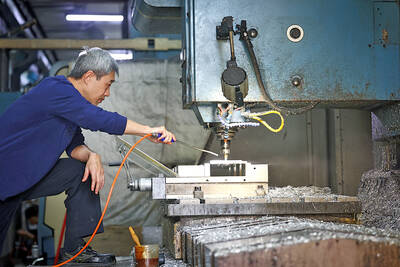Most domestic notebook computer makers saw their share prices drop yesterday due to concern over weakened consumer demand, despite Hewlett-Packard Co's (HP) positive outlook for this quarter.
Compal Electronics Inc (
Shares of Quanta Computer Inc (廣達電腦), the world's largest notebook computer maker, ended 1.58 percent lower at NT$49.9, while those of Wistron Corp (緯創) were down 0.17 percent to NT$59.9.
Wistron is a spin-off of Acer Inc. It supplies notebooks to customers including Acer, Dell Inc and HP.
Asustek Computer Inc (華碩電腦), which supplies laptops to Dell and launched its brandname Eee PCs last month, saw shares rise 0.4 percent to NT$100.
"The share price fall in this sector was caused by the overall market weakness" desspite of HP's favorable balance sheet on Tuesday, Daniel Chang (張博淇), an analyst at Macquarie Research in Taipei, said by telephone yesterday.
The benchmark TAIEX dropped 196.75 points, or 2.27 percent, to 8,484.11, with foreign institutional investors selling a net NT$19.9 billion (US$615.2 million) worth of Taiwanese stocks yesterday, the exchange's tallies showed.
On Monday Hewlett-Packard released stronger-than-expected earnings for last quarter and forecast increased profit and sales for this quarter, with US$0.80 earnings per share and sales of between US$27.4 billion and US$27.5 billion.
Comments by the world's largest PC maker about strong consumer demand and growth outside of the US market were seen as good news for Taiwanese laptop makers, especially Quanta and Compal, Citigroup's equity research team said in a note to investors on Tuesday.
But the ongoing US credit crunch and rising oil prices, which broke US$99 a barrel yesterday, cloud the outlook for local laptop makers ahead of the year-end holiday shopping season, Simon Yang (楊勝帆), a senior researcher at Taipei-based Topology Research Institute (拓墣產研), said in a telephone interview.
Yang said the growing demand in emerging markets may gradually substitute for the softened growth in the US market caused by subprime mortgage problems.
He said 67 percent of HP's revenue was generated by markets outside of the US, especially from the so-called BRIC countries: Brazil, Russia, India and China.
Still, the higher oil prices and US credit turmoil is going to hurt overall consumer demand at the retail end this month and next, he said.
For notebook computers, consumer demand is expected to rise 10 percent this quarter from last quarter, compared to an increase of 12 percent to 15 percent in the past, he said.
In related developments, the value of notebook computer production and shipments by Taiwanese manufacturers is expected to top US$40 billion this year, an Institute for Information Industry (資策會) analyst said yesterday.
Shen Chu-san (沈舉三), deputy director of the institute's Market Intelligence Center, said that Taiwan's computer hardware products, including notebooks, desktops, motherboards, servers and liquid-crystal-displays, had performed excellently in the first half of this year.
The value of notebook production and shipments amounted to approximately US$10 billion per quarter, with production and shipments expected to reach 86 million units worth more than US$40 billion for the whole year, Shen said.
Next year notebook shipments are likely to increase 35 percent to top 100 million units, he said.

SEEKING CLARITY: Washington should not adopt measures that create uncertainties for ‘existing semiconductor investments,’ TSMC said referring to its US$165 billion in the US Taiwan Semiconductor Manufacturing Co (TSMC, 台積電) told the US that any future tariffs on Taiwanese semiconductors could reduce demand for chips and derail its pledge to increase its investment in Arizona. “New import restrictions could jeopardize current US leadership in the competitive technology industry and create uncertainties for many committed semiconductor capital projects in the US, including TSMC Arizona’s significant investment plan in Phoenix,” the chipmaker wrote in a letter to the US Department of Commerce. TSMC issued the warning in response to a solicitation for comments by the department on a possible tariff on semiconductor imports by US President Donald Trump’s

The government has launched a three-pronged strategy to attract local and international talent, aiming to position Taiwan as a new global hub following Nvidia Corp’s announcement that it has chosen Taipei as the site of its Taiwan headquarters. Nvidia cofounder and CEO Jensen Huang (黃仁勳) on Monday last week announced during his keynote speech at the Computex trade show in Taipei that the Nvidia Constellation, the company’s planned Taiwan headquarters, would be located in the Beitou-Shilin Technology Park (北投士林科技園區) in Taipei. Huang’s decision to establish a base in Taiwan is “primarily due to Taiwan’s talent pool and its strength in the semiconductor

Industrial production expanded 22.31 percent annually last month to 107.51, as increases in demand for high-performance computing (HPC) and artificial intelligence (AI) applications drove demand for locally-made chips and components. The manufacturing production index climbed 23.68 percent year-on-year to 108.37, marking the 14th consecutive month of increase, the Ministry of Economic Affairs said. In the first four months of this year, industrial and manufacturing production indices expanded 14.31 percent and 15.22 percent year-on-year, ministry data showed. The growth momentum is to extend into this month, with the manufacturing production index expected to rise between 11 percent and 15.1 percent annually, Department of Statistics

An earnings report from semiconductor giant and artificial intelligence (AI) bellwether Nvidia Corp takes center stage for Wall Street this week, as stocks hit a speed bump of worries over US federal deficits driving up Treasury yields. US equities pulled back last week after a torrid rally, as investors turned their attention to tax and spending legislation poised to swell the US government’s US$36 trillion in debt. Long-dated US Treasury yields rose amid the fiscal worries, with the 30-year yield topping 5 percent and hitting its highest level since late 2023. Stocks were dealt another blow on Friday when US President Donald